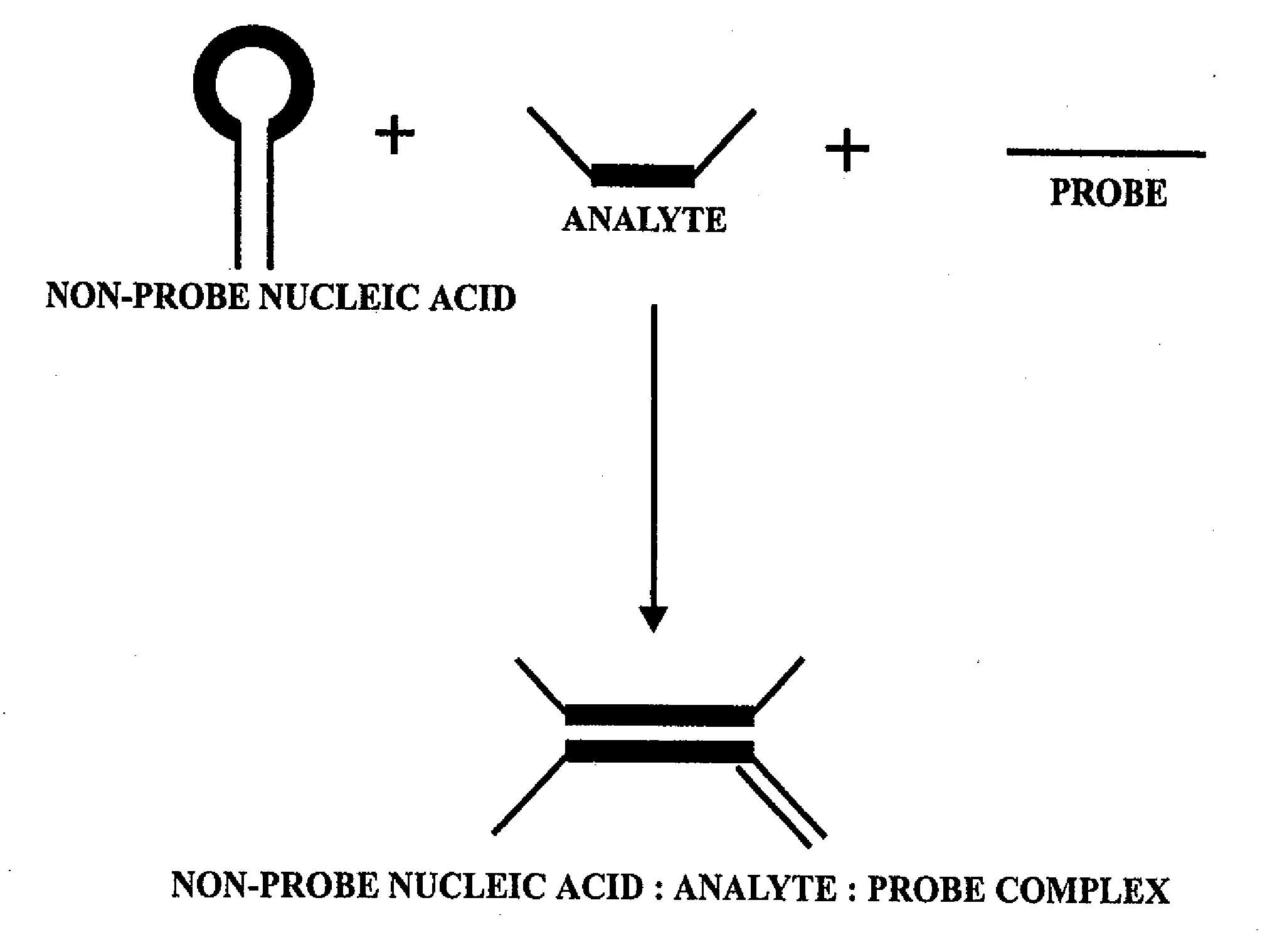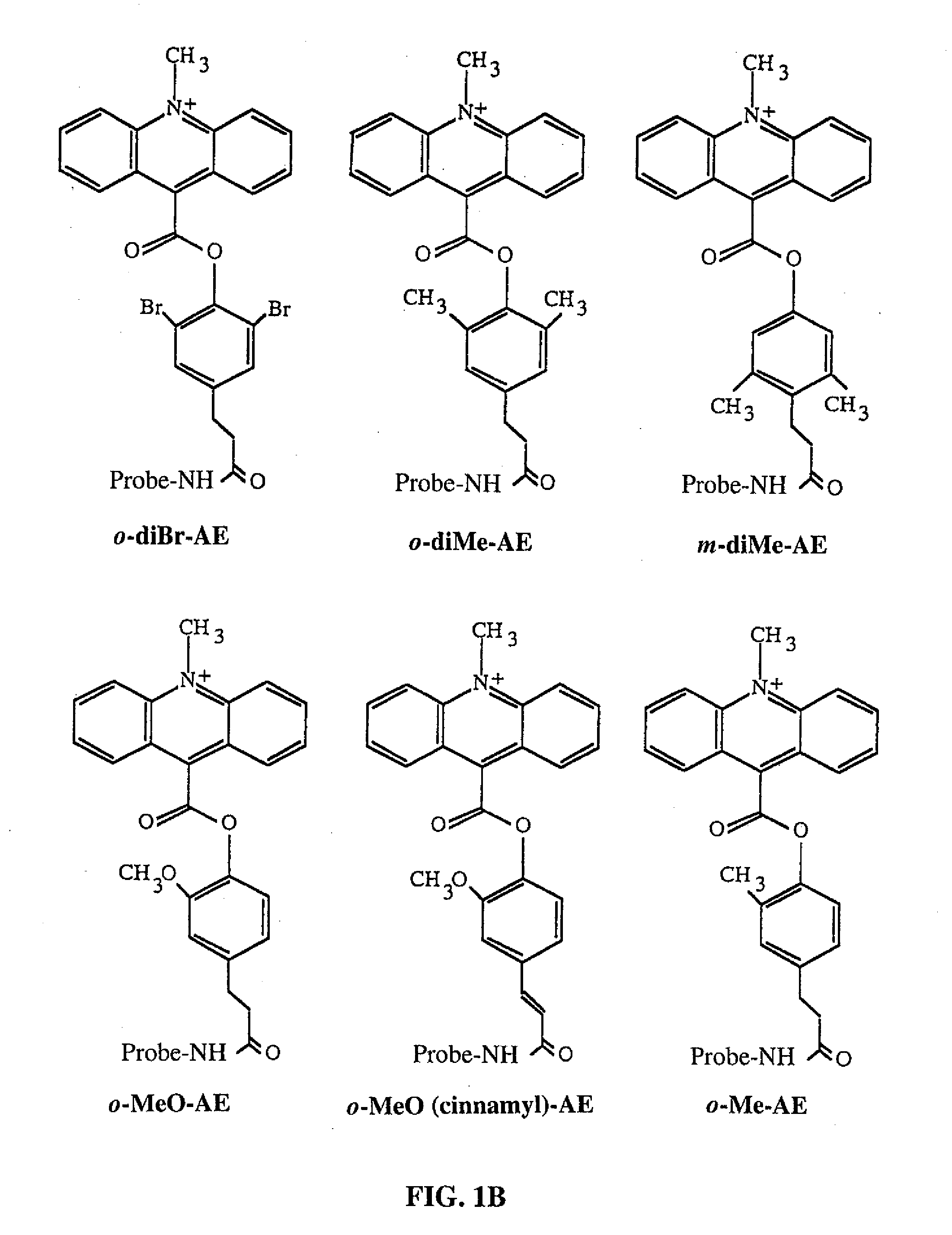Amplification and detection method
a nucleic acid sequence and detection method technology, applied in the field of detecting and amplifying nucleic acid sequences, can solve the problems of inability to use in vivo, nuclease inhibitors, and non-availability of inter-molecular hybridization of oligonucleotides, and achieve faster hybridization rate, faster hybridization rate, and greater discrimination ability
- Summary
- Abstract
- Description
- Claims
- Application Information
AI Technical Summary
Benefits of technology
Problems solved by technology
Method used
Image
Examples
example 1
Effect of 2′ Modifications on the Tm of Probe:Target Hybrids
[0130] Oligonucleotide probes of identical sequence containing varying amounts of 2′-O-methyl nucleotides were each individually hybridized to perfectly complementary synthetic RNA targets of the same length. The target sequence (SEQ ID NO: 1) and the probe sequences (SEQ ID NO:2-6) were as follows (reading 5′ to 3′):
SEQ ID NO:1:atgttgggttaagtcccgcaacgagc;SEQ ID NO:2:gctcgttgcgggacttaacccaacat (Probe A);SEQ ID NO:3:gcucguugcgggacuuaacccaacau (Probe B);SEQ ID NO:4:gcucguugcgggacttaacccaacau (Probe C);SEQ ID NO:5:gctcgttgcgggacuuaacccaacat (Probe D);andSEQ ID NO:6:gctcgttgcgggacuuaacccaacat (Probe E).
[0131] These probes were synthesized to contain no 2′-O-methyl nucleotides (Probe A), all 2′-O-methyl nucleotides (Probe B), or a combination of deoxy- and 2′-O-methyl nucleotides (Probes C, D and E), and each probe was labeled with an acridinium phenyl ester compound joined to a linker arm attached to the probe between nucleo...
example 2
Effect of 2′-Modified Nucleotides on Tm of Probe:rRNA Hybrids
[0135] Three sets of oligonucleotide probes of different length and sequence were synthesized, and each set contained two oligonucleotides of identical base sequence. Probe F was 17 bases in length and included an acridinium ester label joined at a site located between a thymine base and an adenine base. Probe G was 18 bases in length and likewise included an acridinium ester label joined at a site located between a thymine base and an adenine base. Probe H was 20 bases in length and included an acridinium ester label joined at a site located between a thymine base and a guanine base.
[0136] Each set of probes contained one oligonucleotide consisting entirely of deoxyribonucleotides and another oligonucleotide containing only 2′-O-methyl nucleotides. Each probe was then hybridized to the corresponding ribosomal RNA, and the Tm of the resulting hybrids determined by the chemiluminescent method described above. The results ...
example 3
Effect of 2′-Modified Nucleotides on Tm of Probe:DNA Hybrids
[0138] In this Example, the effect of 2′-modification on probe:DNA targets was tested. Probe I, which contained varying amounts of 2′-O-methyl nucleotides, was hybridized to an exactly complementary DNA target of the same length and the melting behavior of the resultant hybrids examined by the chemiluminescent method described above. Probe I was 29 bases in length and included an acridinium ester label joined at a site located between a thymine base and a guanine base.
[0139] Probe I was designed to consist of: (i) all deoxyribonucleotides; (ii) all 2′-O-methyl nucleotides; and (iii) all 2′-O-methyl nucleotides except for four deoxyribonucleotides, which were positioned immediately on each side of the label attachment site. Results of the Tm determination are shown in Table 3 below.
TABLE 3Number of 2′-O-methylΔTm per modifiedProbenucleotidesTmnucleotideI0690I29770.28I21750.29
[0140] As the data shows, replacement of deoxy...
PUM
| Property | Measurement | Unit |
|---|---|---|
| pH | aaaaa | aaaaa |
| pH | aaaaa | aaaaa |
| temperatures | aaaaa | aaaaa |
Abstract
Description
Claims
Application Information
 Login to View More
Login to View More - R&D
- Intellectual Property
- Life Sciences
- Materials
- Tech Scout
- Unparalleled Data Quality
- Higher Quality Content
- 60% Fewer Hallucinations
Browse by: Latest US Patents, China's latest patents, Technical Efficacy Thesaurus, Application Domain, Technology Topic, Popular Technical Reports.
© 2025 PatSnap. All rights reserved.Legal|Privacy policy|Modern Slavery Act Transparency Statement|Sitemap|About US| Contact US: help@patsnap.com



